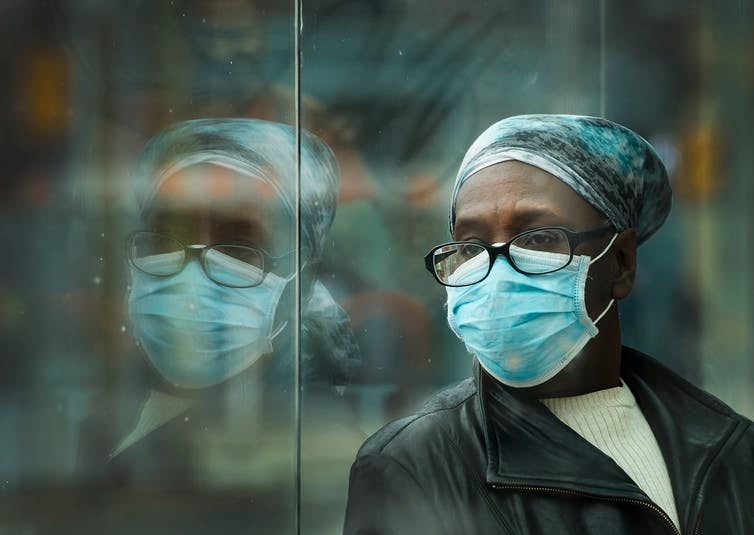Identifying Vulnerable COVID-19 Demographics
"There's a sense that if we were to collect socio-demographic data that includes things like race, ethnicity and income, we can get a better sense of what's actually happening."
"I think given the specific pandemic, we should be much more nimble and responsive and able to actually ensure that we're doing things effectively."
Paul Bailey, president, Black Health Alliance
 |
| A woman waits for a streetcar in Toronto on April 16, 2020. Many Black community members who work in essential jobs do not have the luxury of staying home during the pandemic (photo by Nathan Denette/Canadian Press) |
The Public Health Agency of Canada is considering the possibility of collecting more demographic data related to the disease, following months of calls from advocates for a clearer idea of who, within the general population is contracting COVID-19 and how those populations identified as vulnerable are being affected by the global pandemic.
In the United States, public health officials have discovered that the deadly virus was affecting black communities disproportionately. Researchers at several American universities recently released a study finding counties in the U.S. representing the highest proportions of black Americans have been responsible for over half of all COVID-19 cases, and 60 percent of deaths in the country. This, even though they make up 22 percent of counties. The study was led by the Foundation for AIDS Research and Emory University, awaiting peer review.
In Canada, advocates insist a similar situation is more than likely to be playing out on a smaller scale. Yet because government fails to collect data it is difficult to understand which segments of the population may be most at risk. This, aside from the demonstrable reality that Canadian long-term care establishments and seniors residents have been responsible, between them, for at the very least fifty percent of all COVID-19 relatable deaths.
 |
| In Chicago, black residents are 30 per cent of the population, but make up more than 70 per cent of COVID-19-related deaths. Canada doesn't track racial data, something many advocates would like to see change. (CBC/Radio-Canada) |
Marking the reality that the elderly vulnerable and the health-impaired have been the largest demographic in global death rates, and that within Canada a larger-than-average by far vulnerability to COVID-related deaths. They are vulnerable on a number of counts; that they are frail, elderly and health-impaired, and assembled in close quarters where social distancing is difficult to obtain, while being cared for by inadequately-trained-and-remunerated aides.
A situation not that far off the mark for black Canadians who are more likely to have poor health outcomes in chronic diseases, more greatly impacted by socio-economic factors such as poor access to healthy food, housing and employment than the general population. Factors in the aggregate that place them at higher risk from COVID-19.
In Canada only basic data about people who test positive for the disease is currently gathered, including age and gender. "I think there's a number of gaps in that data", suggested Dr.Theresa Tam, Canada's premier public health officer who stated that efforts are underway to examine how to improve the situation. "Everyone is stretched in terms of working under extreme circumstances", elaborated her deputy, Dr.Howard Njoo, stating that the situation must be balanced against the workload.
 |
| Paramedics transfer a patient to the emergency unit at Verdun Hospital, Tuesday, April 14, 2020 in Montreal. (THE CANADIAN PRESS / Ryan Remiorz) |
Labels: Canada, Demographics, Novel Coronavirus, Victims, Vulnerability

<< Home